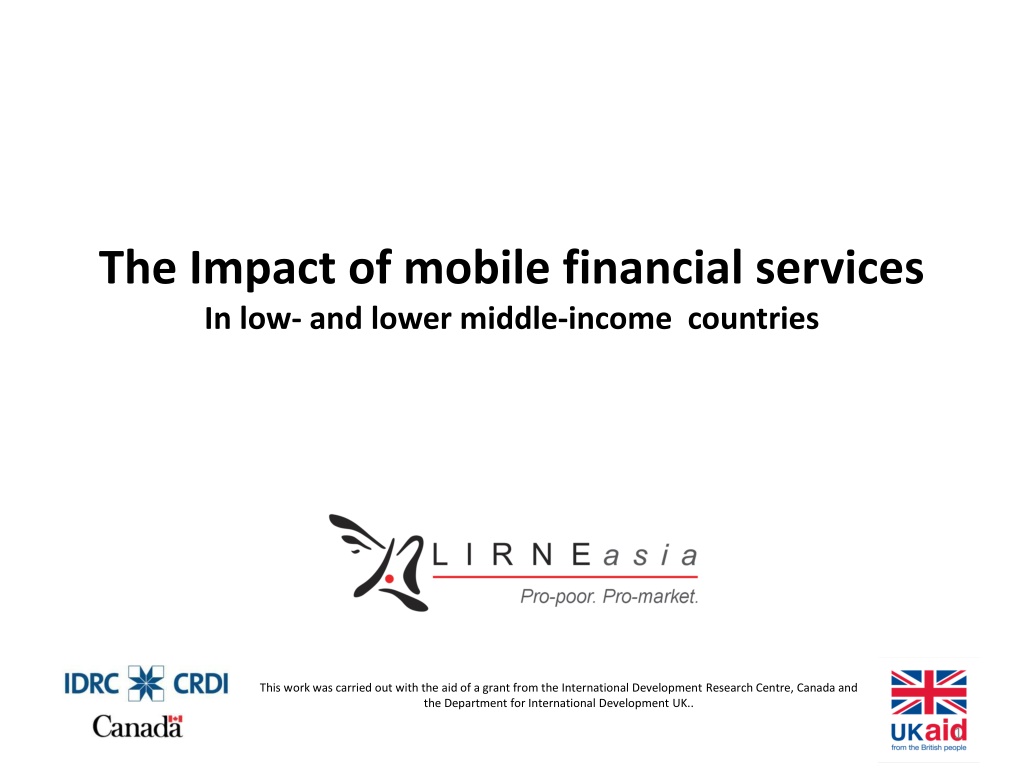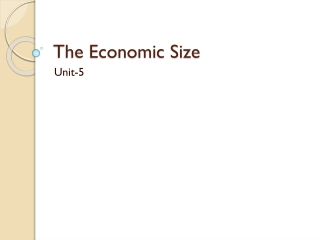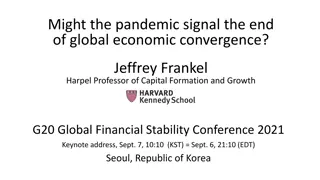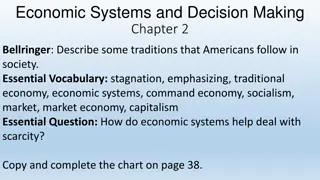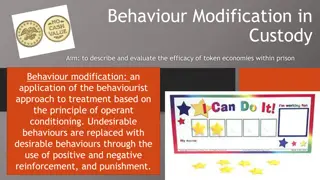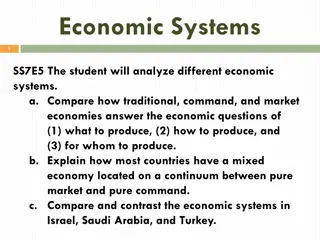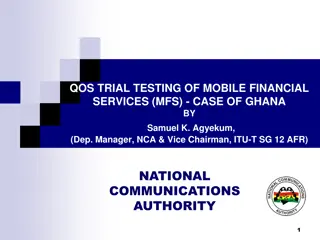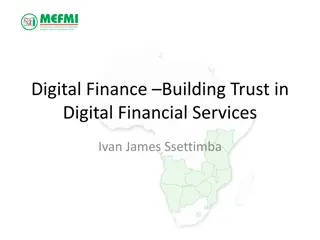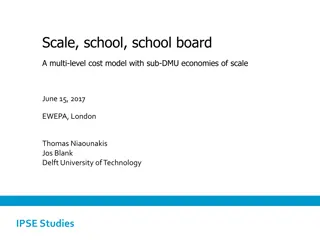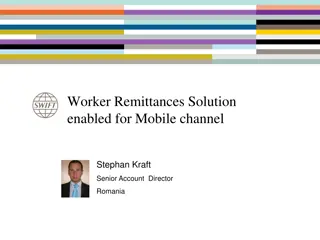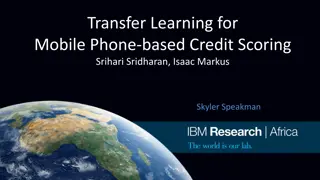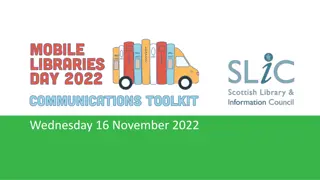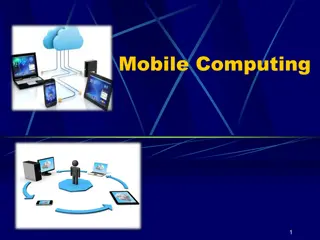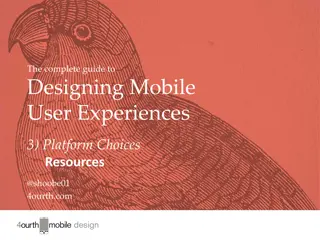Exploring the Impact of Mobile Financial Services in Developing Economies
Conducted in low- and lower-middle-income countries, this research delves into the potential impact of mobile financial services on various socio-economic aspects. The systematic review team analyzed studies on consumer adoption, market analysis, technical frameworks, and more to understand the implications on financial inclusion, savings behavior, consumption patterns, and livelihood improvements. Theoretical frameworks and search results further elucidate the significance and implications of m-financial services in these regions.
- Mobile financial services
- Developing economies
- Financial inclusion
- Systematic review
- Socio-economic impact
Download Presentation

Please find below an Image/Link to download the presentation.
The content on the website is provided AS IS for your information and personal use only. It may not be sold, licensed, or shared on other websites without obtaining consent from the author. Download presentation by click this link. If you encounter any issues during the download, it is possible that the publisher has removed the file from their server.
E N D
Presentation Transcript
The Impact of mobile financial services In low- and lower middle-income countries This work was carried out with the aid of a grant from the International Development Research Centre, Canada and the Department for International Development UK.. 1
Systematic Review Team Erwin A. Alampay Goodiel Charles Moshi Ishita Gosh Juliana Harshanti Mina Peralta What has been mobile financial services impact in low and lower- middle income countries?
Previews reviews Of the 5 Impact Studies that Duncombe and Boateng highlighted at the micro level none ended up in the final list for this SR PRE-CURSOR REVIEWS: Duncombe & Boateng (2009) Mobile Phones and Financial Services in Developing Countries: a review of concepts, methods, issues, evidence and future research directions Third World Quarterly Volume 30, Issue 7, 2009 ) Papers Themes: Consumer adoption Market analysis MM for the BoP Technical Frameworks Merchant adoption Analysis for Failures Technological Factors Diniz, Albuquerque and Cernev (2011) Mobile Money and Payment: a literature based review on academic and practitioner oriented publications (2001-2011)
Theoretical Framework CONTEXT Low to low-middle income countries INTERMEDIATE OUTCOMES DEVELOPMENT IMPACT INTERVENTION Financial Inclusion/Increased access to funds Savings Patterns/Behavior Consumption patterns Social capital/Power relation Livelihoods - Investments - Inclusion in Markets - Income M- Knowledge of services Efficiencies ADOPTION /USE financial services
Search Results= 2759 331 355 41 99 21 100 Econlit CAB_EBSCO CAB Abst *(Ovid) Business Source EBSCO search 603 TOC Premier Public Affairs Index WOS Search 1209
Exclusion criteria Exclude before 2000 publications hi-income and upper middle income not using mobile phones not on mobile money not on impact (e.g. only adoption, feasibility) Theoretical only qualitative only policy paper only
FIRST SCREENING + 88 more from the Grey Literature 229 We used double screening and conflicts was resolved by a third screener (622 cases) Excluded Included 2530
Quick scan of final 229 24 repeats ---- 205 final list Frequency of Publications 35 30 30 25 22 20 18 15 11 10 10 6 6 6 5 5 1 1 0 2001 2003 2006 2007 2008 2009 2010 2011 2012 2013 2014
FILTERING Electronic Search 2759 list Double screening of titles/abstracts 205 AFTER FIRST Screening Double screening of full documents 109 PLUS GREY LIT AFTER 2ND screening Critical Appraisal Final 12 PLUS 2015 GREY LIT
Final list Paper title Paper title Author Author YEAR YEAR Jack, W., Ray, A. and Suri, T 2013 Transaction Networks: Evidence from Mobile Money in Kenya Mbiti, I. and Weil, D 2011 Mobile Banking: The Impact of M-Pesa in Kenya Jack, W., and Suri, T 2014 Risk Sharing and Transaction Costs: Evidence from Kenya's Mobile Money Revolution Risk sharing and mobile phones: evidence in the aftermath of Risk sharing and mobile phones: evidence in the aftermath of natural disasters) natural disasters) Blumenstock, Eagle and Fafchamps 2014 2014 (new (new version) version) Aker, J. et. al. 2011 Zap It to Me: The Short-Term Impacts of a Mobile Cash Transfer Program Introducing Mobile Money in Rural Mozambique: Evidence from a Field Experiment Batista, C. and Vicente, P. 2013
Final list Paper title Paper title Author Author YEAR YEAR Kirui, O., et. al. 2013 Impact of Mobile Phone-Based Money Transfer Services in Agriculture: Evidence from Kenya Mobile Money, Remittances and Rural Household Welfare: Panel Evidence from Uganda Mobile Money, Smallholder Farmers, and Household Welfare in Kenya Kenya s Mobile Revolution and the Promise of Mobile Savings Munyegera & Matsumoto 2014 Kikulwe, E., et. al. 2014 Demombynes & Thegeya 2012 Renteria 2015 (forthcomi ng) 2015 How transformational mobile banking optimize household expenditure. Case study from rural communities in Mexico Blumenstock, et.al. Promises and pitfalls od Mobile Money in Afghanistan: Evidence from a Randomized Control Trial
DESIGNS Author(s), Year Jack, W., Ray, A. and Suri, T. 2013 Mbiti, I. and Weil, D. 2011 Jack, W. and Suri, T. 2014 Aker, J., Boumnijel, R., McClelland, A. and Tierney, N. 2011 Batista, C. and Vicente, P. 2013 Kirui, O., Okello, J., Nyikal, R. and Nyiraini, G. 2013 Munyegera, G and Matsumoto, T. 2014 Kikulwe, E., Fischer, E., and Qaim, M. 2014 Bemombyne, G. and Thegeya, A. 2012 Renteria, C.2015 forthcoming Blumenstock, etc. al (2015) Design, Methodology 2 period panel ; OLS 2-period panel; DiD 2-period panel;DiD RCT; simple difference RCT; OLS Cross-sectional; PSM 2-period panel; DiD 2-period panel; Fixed effect regression Cross-section; OLS, Probit and IV Cross-section; PSM RCT
Breakdown of papers by country 1 1 Kenya Mozambique 1 Uganda Mexico 6 Niger 1 Rwanda Afghanistan 1 1
M-money use for transfers Easier access to network of m-money users More accessible than banks No need t physically transfer cash More private Easier Reciprocity within social network More secure, safe and certain Wider diversity Of fund sources Less logistical cost to send Transaction can reach farther distances faster Can be Consumed in outside and local markets Less cost of transfers Less charges Consumption Decisions (e.g. what to buy, send credit, support, insurance) Less opportunity costs lost due to time Change Remittance patterns Larger value of amounts received Lower Commission For other Transfer methods Increased market participation (e.g. m- commerce) More money to use More frequent transfers More to invest livelihoods More to spend More To save/Use as saving instrument Higher economic activity in community Smoothen consumption patterns, reduces liquidity constraints Higher income
Theory of Change Short term Short term impact impact Longer Longer- -term term impact term term impact Intervention Intervention Outcome Outcome Women empowerment General consumption Non-income e.g.. health and education Insurance (reciprocal, & shock smoothening) Frequency & Volume of REMITTANCES Improved livelihood Income + Mobile Financial Services Efficient, secure, accessible Investment Employment (platform, embedded services and farm jobs) Farm inputs + Savings Banking
Efficiency Gains Not necessarily a development impact, and many other studies in the literature estimate this. Problem also of separating the gain from just having a mobile phone (e.g. Renteria 2015) Among the final list only Aker, et.al. and Blumenstock et.al (2015) provides an estimate. Aker, estimate that manual distribution of cash transfers are 30% more expensive than using thru m-Zap. Blumenstock et. al (2015) estimates approx. 50% cost per employee savings per month if using m-money. Not in the final list, Hope, Foster Krolikowski and Cohen (2011) documented effect in time and cost for paying water bills.
IMPACT ON REMITTANCE TRANSFERS Frequency In Kenya, it increases likelihood of receiving and sending remittances by 37.4% and 34.3% (Jack, & Suri, 2013). Mbiti & Weil (2011:16) also report the positive relationship in its (MPESA) adoption and frequency of sending and receiving transfers (only) sending transfers was statistically signficiant. In Uganda were they reported a 56% difference between users and non-users in terms of frequency of remittances received (Munyegera et. al. 2014). In Niger, Aker, et. al. (2012) also reported that the frequency and amount of remittances by people with mobile phones with Zap were higher than those without the service (but not significant) SMOOTHENS FINANCIAL FLOWS MORE RECIPROCITY IN SHORT TERM
IMPACT ON REMITTANCE TRANSFERS Volume of remittances/transfers Kenya: 33.1 and 32.6 KsH higher amounts of remittance sent and received by households with MPESA in (p<0.01 for both) (Jack & Suri 2013). Also rural households users received KSh. 12,697 more than non user HH's (equivalent to 66%, p<0.05) (Kikulwe,et. al. 2014) Uganda: a 43% higher total value of remittance received (p<0.01) (Munyegera &Matsumota 2014). Rwanda: airtime transfers also increase during shocks Blumenstock, et.al. (2011) Afghanistan : no evidence of increase in receiving or sending for mPaisa users (Blumenstock et. al 2015).
IMPACT ON SAVINGS However, it is difficult to determine where the savings are reapprpriated, especially when not all studies try to measure the same possible options/uses. Kenya: + association between MPESA adoption, bank use and savings and employmant (Mbiti and Weil 2011:16) Reduces informal savings (-38.3%,p<0.05), the practice of hiding money for saving (-77.2%, p<0.01), but interestingly, it also translates to a positive increase in formal saving (+27.3 %, p<0.01) Amount of monthly saving (OLS: +11.8%, p<0.05 | | IV: +31%, NS) (Demombynes and Thegaya 2012) Mozambique: General saving (+4.3%, NS); mKesh saving (+24.9%, p<0.01) Afghanistan: users ore likely to save on MPAisa, but total savings did not significanty differ with non-users (Blumenstock, et. al 2015)
IMPACT ON CONSUMPTION OF GOODS + Per capita consumption increases Munyegera & Matsumoto (2014) USD 29 to USD 47 (13% increase in per capita consumption for users + $42 difference for consumption of agricultural inputs Kirui, et. al (2012) Niger: in the types of food and non-food items they consumed (+20.1%, p<0.01) (AKER et. al). More diverse diet; higher non staple grains, more fats HOWEVER: Renteria (2015-forthcoming) saw no change in homecare, education, fuel and energy consumption even with an m-money intervention. Blumenstock et.al.(2015) larger and more frequent airtime purchases
INSURANCE: CONSUMPTION DURING SHOCKS For non-user, in case of a general shock (- 7.37%,p<0.1) For users, in case of an illness shock (+7.81%, p<0.1) Non-health consumption in case of an illness shock, for nonuser (-8.68%,p<0.1) For the poor in case of a general shock, for users (+12.7%,p<0.01) Jack and Suri, 2014
IMPACT ON LIVELIHOODS Diversity in the basket of crops production (+8.1%, p<0.1) (Aker) Commercialization is 37% higher (p < 5%), input use higher by USD 42 (p<10%) leading a HH income increase by $224 m-money HH users, income rose by USD 224 (p<1%) (Kirui, et. al 2012)
OTHER IMPACT Impact on other remittance channels: greater usage reduced use of other channels (formal/informal) commission fees: from 7% in 2003 to 3% in 2010 (Mbiti & Weil 2011:12) Impact on women empowerment was indicated in one study but not quantified
SUMMARY OUTCOMES Outcomes (direction, raw effects of the intervention on the treatment group, statistical significance) Note: NS not significant Regular support remittance (+24.2%, p<0.01) Credit remittance (informal loans) (+15.1%,p<0.01 Emergency remittance (+13.2%, p<0.01) Saving Informal saving (-38.3%,p<0.05) Hide money for saving (-77.2%, p<0.01) Formal saving (+27.3 %, p<0.01) Loans Formal (+0.3%, NS) Informal (+4.6%, NS) Employment General employment (+30.8%, p<0.01) Employed in non-farm jobs (+9.4%,NS) Banking (+27.9%, p<0.01) Income (+Ksh 17,757,p<0.01) Input use (consumption) (+Ksh 3079, p<0.1) Commercialization (financial inclusion) (+37%, p<0.05) Author(s), Year Jack, W., Ray, A. and Suri, T. 2013 Mbiti, I. and Weil, D. 2011 Kirui, O., Okello, J., Nyikal, R. and Nyiraini, G. 2013
SUMMARY OUTCOMES Consumption For non-user, in case of a general shock (- 7.37%,p<0.1) For users, in case of an illness shock (+7.81%, p<0.1) Non-health consumption in case of an illness shock, for nonuser (-8.68%,p<0.1) For the poor in case of a general shock, for users (+12.7%,p<0.01) Types of food and non good items consumed (+20.1%, p<0.01) Diet diversity (+14%, p<0.05) Depletion of non-durable assets (measured as non-durable assets owned)(+20.3%, p<0.01) Diversity in the basket of crops production (+8.1%, p<0.1) Note: 1. The results have been changed to percentage change 2. ZAP group over placebo results have been reported, since they decouple effects of mobile phone service on the intervention Saving General saving (+4.3%, NS) mKesh saving (+24.9%, p<0.01) Jack, W. and Suri, T. 2014 Aker, J., Boumnijel, R., McClelland, A. and Tierney, N. 2011 Batista, C. and Vicente, P. 2013
Consumption (+72.7%, p<0.1) Munyegera, G and Matsumoto, T. 2014 Kikulwe, E., Fischer, E., and Qaim, M. 2014 Income (+KSh. 61,470, p<0.1) Farm inputs use (cash used for) Hired labor (+KSh. 4,122, p<0.05) Organic fertilizer (+KSh. 2,502, p<0.05) Mineral fertilizer (-KSh. 1,640, NS) Pesticides (+KSh. 1,212, p<0.1) Farm income Proportional of output sold (+10.4%p<0.1) Profits (+KSh. 30,112, p<0.1) *note: all values per acre Saving Amount of monthly saving (OLS: +11.8%, p<0.05 | | IV: +31%, NS) Likelihood of saving(+19%, p<0.01) Consumption Homecare (+USD 0.54, NS) Education (+USD 5.65, NS) Communication (with telecom subscription) (+USD2.63, NS) Communication (w/out telecom subscription) (-USD10.15, p=0.023) Fuel (-USD1.08, NS) Energy (-USD18, NS) Public Transportation(-USD10.54, p=0.005) Bemombyne, G. and Thegeya, A. 2012 Renteria, C.2015 forthcoming
Constraints to Meta Analysis A lot of missing data, and statistics not reported in detail Large variety of outcomes which makes it difficult to combine them together (e.g. savings, insurance, consumption (food; health)) Need for more empirical impact studies in Asia and Latin America
Theory of Change Short term Short term impact impact Longer Longer- -term term impact term term impact Intervention Intervention Outcome Outcome Women empowerment General consumption Non-income e.g.. health and education Insurance (reciprocal, & shock smoothening) Frequency & Volume of REMITTANCES Improved livelihood Income + Mobile Financial Services Efficient, secure, accessible Investment Employment (platform, embedded services and farm jobs) Farm inputs + Savings Banking
THANK YOU eaalampay@up.edu.ph This work was carried out with the aid of a grant from the International Development Research Centre, Canada and the Department for International Development UK..
